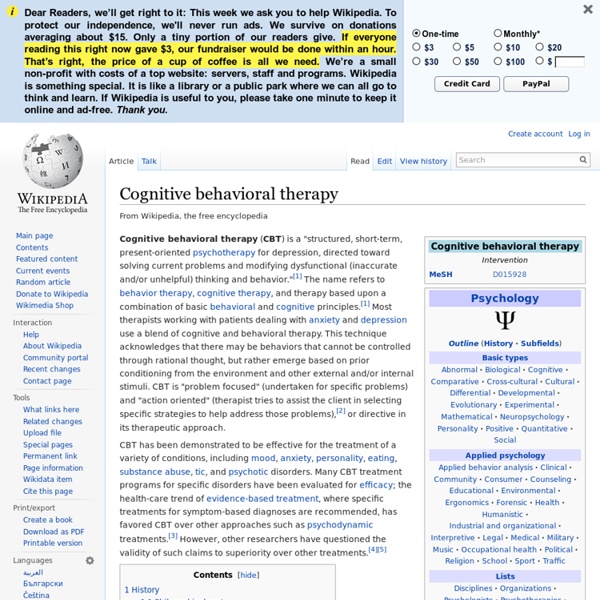Synchronicity (The Police album)
In 2009, Synchronicity was inducted into the Grammy Hall of Fame. In the 1983 Rolling Stone readers poll, Synchronicity was voted "Album of the Year". The album marked a significant reduction in the reggae influences that were a part of the band's first four records, instead featuring production-heavy textures and liberal use of synthesizers that, at times, drove entire songs ("Synchronicity I", "Wrapped Around Your Finger").
Cognitive Behavioral Treatments for PTSD - Types of Cognitive Behavioral Treatments for PTSD
Cognitive behavioral treatments for PTSD have been found to be very successful in reducing peoples' symptoms and improving their quality of life. Several different therapies would be considered "cognitive-behavioral" that are regularly used to treat PTSD: Exposure TherapyStress-Inoculation TrainingCognitive Processing Therapy
Judith Ayre - Process Experiential Emotion Focused Therapy (PEEFT) for individuals and couples.
Process-Experiential Emotion-Focused Therapy (PEEFT) Process-Experiential Emotion-Focused Therapy (PEEFT) is a totally holistic approach that suits many different people. It can be very helpful for people who either find it hard to regulate their emotions or who feel that their emotions are spilling over uncomfortably into other areas of their life. Equally, it is effective for people who notice that they experience little or no emotion in their life or who are perceived by others to 'live in their heads' or be too 'ultra-rational' too much of the time. History of Process-Experiential Emotion-Focused Therapy (PEEFT) in Melbourne, Australia In the 1990s, Dr George Wills of LaTrobe University became interested in the work of Robert Elliott, Laura Rice and Les Greenberg.
Eugen Bleuler
Paul Eugen Bleuler (;[1] German: [ˈɔɪɡeːn ˈblɔɪlər]; 30 April 1857 – 15 July 1939)[2] was a Swiss psychiatrist and eugenicist[3] most notable for his contributions to the understanding of mental illness. He coined many psychiatric terms, such as "schizophrenia",[4][5] "schizoid",[6] "autism",[7] depth psychology and what Sigmund Freud called "Bleuler's happily chosen term ambivalence".[8] Personal life[edit] Bleuler was born in Zollikon, a town near Zürich in Switzerland, to Johann Rudolf Bleuler, a wealthy farmer, and Pauline Bleuler-Bleuler.[9] He married Hedwig Bleuler–Waser, one of the few women to receive her doctorate from the University of Zurich.[10]
What is Asperger syndrome?
Here we explain more about Asperger syndrome - a form of autism - including the three main difficulties that people with Asperger syndrome share, how many people have the condition, and what may cause it. As soon as we meet a person we make judgements about them. From their facial expression, tone of voice and body language we can usually tell whether they are happy, angry or sad and respond accordingly. People with Asperger syndrome can find it harder to read the signals that most of us take for granted.
exulansis
“Creates beautiful new words that we need but do not yet have.” — John Green, author of The Fault in Our Stars The Dictionary of Obscure Sorrows is a compendium of invented words written by John Koenig. Each original definition aims to fill a hole in the language—to give a name to emotions we all might experience but don’t yet have a word for.
Asperger syndrome
Asperger syndrome (AS), also known as Asperger disorder (AD) or simply Asperger's, is an autism spectrum disorder (ASD) that is characterized by significant difficulties in social interaction and nonverbal communication, alongside restricted and repetitive patterns of behavior and interests. It differs from other autism spectrum disorders by its relative preservation of linguistic and cognitive development. Although not required for diagnosis, physical clumsiness and atypical (peculiar, odd) use of language are frequently reported.[1][2] The syndrome is named after the Austrian pediatrician Hans Asperger who, in 1944, studied and described children in his practice who lacked nonverbal communication skills, demonstrated limited empathy with their peers, and were physically clumsy.[3] The modern conception of Asperger syndrome came into existence in 1981[4] and went through a period of popularization,[5][6] becoming standardized as a diagnosis in the early 1990s. Classification
Liminality
In anthropology, liminality (from the Latin word līmen, meaning "a threshold"[1]) is the quality of ambiguity or disorientation that occurs in the middle stage of rituals, when participants no longer hold their pre-ritual status but have not yet begun the transition to the status they will hold when the ritual is complete. During a ritual's liminal stage, participants "stand at the threshold" between their previous way of structuring their identity, time, or community, and a new way, which the ritual establishes. Rites of passage[edit] Arnold van Gennep[edit] Van Gennep, who invented the term liminality, published in 1908 his Rites de Passage, a work that is essential to the development of the concept of liminality in the context of rituals in small-scale societies.


